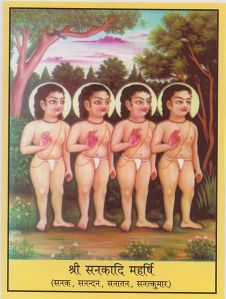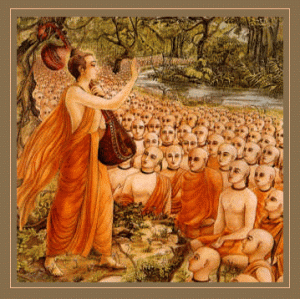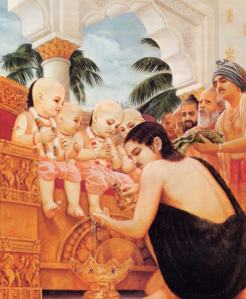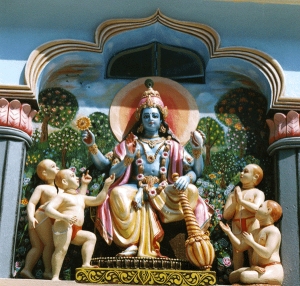 At the beginning of the process of creation, Lord Brahma created the ‘Four Kumaras’ or the ‘Catursana’.
At the beginning of the process of creation, Lord Brahma created the ‘Four Kumaras’ or the ‘Catursana’.As the Four Kumaras were born from the mind (manas) of Brahma they are referred to as his Manasaputras.
Their names are : Sanaka, Sanandana, Sanatana and Sanat Kumara.
When the four Kumaras came into existence, they were all embodiments of pure qualities. They did not have any sign of negative qualities like laziness, sleep etc.
Now Lord Brahma had created these four Kumaras so that they could help in the process of creation.
However, the Kumaras (kumara means unmarried) refused his order to procreate and instead devoted themselves to God and celibacy (brahmacarya).
They requested their father for the boon of remaining perpetually five years old.
The Four Kumaras are mentioned numerous times in the Puranas as well as the Upanisads.
1. According to a verse in the Srimad Bhagavatam (6.3.20-21)
svayambhur naradah sambhuh
kumarah kapilo manuh
prahlado janako bhismo
balir vaiyasakir vayam
dvadasaite vijanimo
dharmam bhagavatam bhatah
guhyam visuddham durbodham
yam jnatvamrtam asnute
Meaning - "Lord Brahma, Bhagavan Narada, Lord Siva, the Four Kumaras, Lord Kapila, Svayambhuva Manu, Prahlada , Janaka Maharaja, Grandfather Bhishma, Bali Maharaja, Sukadeva Gosvami and I myself know the real religious principle."
2. In the 11th Canto of the Bhagavata Purana Lord Sri Krishna in His conversation with Uddhava declares:
etavan yoga adisto macchisyaih sanakadibhih
Meaning – "I taught this yoga to my disciples, the four brothers headed by Sanaka."
3. According to a verse in the Padma Puraṇa,
sampradāyavihīnā ye mantrāste niṣphalā matāḥ|
ataḥ kalau bhaviśyanti catvāraḥ sampradāyinaḥ||
Śrī-brahmā-rudra-sanakā vaiṣṇavā kṣitipāvanāḥ|
catvāraste kalau bhāvya hyutkale puruṣottamāt||
rāmānujaṃ śrī svicakre madhvācaryaṃ caturmukhaḥ|
śrīviṣṇusvāminaṃ rudro nimbādityaṃ catuḥsanāḥ||
Meaning - All mantras which have been given (to disciples) not in an authorised Sampradāya are fruitless. Therefore, in Kali Yuga, there will be four bona-fide Sampradāyas. Each of them were ignaugurated by Śrī Devī and known as the Śrī Sampradāya, Lord Brahmā and known as the Brahmā Sampradāya,Lord Rudra and known as the Rudra Sampradāya; and the Four Kumāras and known as Sanakādi Sampradāya. Śrī Devī made Rāmānujācārya the head of that lineage. So too Lord Brahmā appointed Madhvācārya, Lord Rudra appointed Viṣṇusvāmī and the four Kumaras chose Nimbāditya (an epithet for Śrī Nimbārkācārya).
The Nimbarka Sampradaya also known as the Hamsa Sampradaya, Kumara Sampradaya, Catuḥ Sana Sampradaya and Sanakadi Sampradaya, is one of the four ‘authorised’ Vaiṣṇava Sampradāyas.
4. According to a story from the Bhagavata Purana, the Four Kumaras once visited Vaikuntha, the abode of Vishnu, to see him.
Due to the boon from their father Brahma and the strength of their tapas, the Four Kumaras lloked like 5 year olds. Jaya and Vijaya, the gate keepers of the Vaikuntha stopped the Kumaras at the gate, thinking them to be children. They told the Kumaras that Sri Vishnu is resting and that they cannot see him now. The enraged Kumaras cursed both Jaya and Vijaya, that they would have to give up their divinity, be born as mortals on Earth (bhuloka), and live like normal human beings.
This curse was eventually 'diluted' to Jay and Vijaya choosing to be born three times on Earth as enemies of Vishnu. (more on this in another post later)
5. Nārāyaṇamukhambhojānmantrastvaṣṭādaśākṣaraḥ|
Āvirbhūtaḥ kumāraistu gṛhītvā nāradāya ca||
This holy eighteen-syllabled mantra known as Śrī Gopāla Mantra was given by Lord Vishnu to the Four Kumaras and was in turn passed to the disciple of the Kumaras, Narada Muni.
This mantra is the Vaidika mantra from the Gopalatapinyupaniṣad of the Atharva Veda.
 Narada Muni took initiation from his elder brothers, the Kumaras and their discussions as guru and disciple are recorded in the Upaniṣads with a famous conversation in the Chandogya Upaniṣad.
Narada Muni took initiation from his elder brothers, the Kumaras and their discussions as guru and disciple are recorded in the Upaniṣads with a famous conversation in the Chandogya Upaniṣad.6.
 The dialogue between King Prithu and the Four Kumaras found in the Bhagvata Purana in which the Kumaras preached Prithu about devotion to Vishnu is one of the finest writings on bhakti.
The dialogue between King Prithu and the Four Kumaras found in the Bhagvata Purana in which the Kumaras preached Prithu about devotion to Vishnu is one of the finest writings on bhakti.Thus we see that the first attempt by Brahma to increase the population on earth failed.
What was his next step?
Find out in the next post.

No comments:
Post a Comment